Application of GWO-ELM Model to Prediction of Caojiatuo Landslide Displacement in the Three Gorge Reservoir Area
Abstract
1. Introduction
2. The Proposed Landslide Displacement Prediction Model
2.1. Time Series Model
2.2. Extreme Learning Machine Model
2.3. Gray Wolf Optimization
2.4. Proposed Prediction Model Based on GWO-ELM
3. Caojiatuo Landslide
3.1. Geologic Aspects
3.2. Monitoring Data Analysis
4. Case Study
4.1. Prediction of Trend Displacement
4.2. Prediction of Periodic Displacement
4.2.1. The External Influencing Factors
4.2.2. Prediction by GWO-ELM Model
4.2.3. Analysis of Prediction Results
4.3. Prediction of the Accumulative Displacement
5. Conclusions
Author Contributions
Funding
Acknowledgments
Conflicts of Interest
References
- Pradhan, S.P.; Panda, S.D.; Roul, A.R.; Thakur, M. Insights into the recent Kotropi landslide of August 2017, India: A geological investigation and slope stability analysis. Landslides 2019, 16, 1529–1537. [Google Scholar] [CrossRef]
- Zhou, W.; Shi, X.; Lu, X.; Qi, C.; Luan, B.; Liu, F. The mechanical and microstructural properties of refuse mudstone-GGBS-red mud based geopolymer composites made with sand. Constr. Build. Mater. 2020, 253. [Google Scholar] [CrossRef]
- Li, C.; Fu, Z.; Wang, Y. Susceptibility of reservoir-induced landslides and strategies for increasing the slope stability in the Three Gorges Reservoir Area: Zigui Basin as an example. J. Eng. Geol. 2019, 261. [Google Scholar] [CrossRef]
- Wang, Z.-H.; Li, L.; Zhang, Y.-X. Reinforcement model considering slip effect. J. Eng. Struct. 2019, 198, 109493. [Google Scholar] [CrossRef]
- Xu, S.; Niu, R. Displacement prediction of Baijiabao landslide based on empirical mode decomposition and long short-term memory neural network in Three Gorges area, China. Comput. Geosci. 2018, 111, 87–96. [Google Scholar] [CrossRef]
- Carla, T.; Macciotta, R.; Hendry, M.; Martin, D.; Edwards, T.; Evans, T.; Farina, P.; Intrieri, E.; Casagli, N. Displacement of a landslide retaining wall and application of an enhanced failure forecasting approach. Landslides 2018, 15, 489–505. [Google Scholar] [CrossRef]
- Shinoda, M.; Miyata, Y.; Kurokawa, U.; Kondo, K. Regional landslide susceptibility following the 2016 Kumamoto earthquake using back-calculated geomaterial strength parameters. Landslides 2019, 16, 1497–1516. [Google Scholar] [CrossRef]
- Guo, F.; Luo, Z.; Li, H.; Wang, S. Self-organized criticality of significant fording landslides in Three Gorges Reservoir area, China. Environ. Earth Sci. 2016, 75. [Google Scholar] [CrossRef]
- Bao, Y.; Han, X.; Chen, J.; Zhang, W.; Zhan, J.; Sun, X.; Chen, M. Numerical assessment of failure potential of a large mine waste dump in Panzhihua City, China. Eng. Geol. 2019, 253, 171–183. [Google Scholar] [CrossRef]
- Zhou, C.; Yin, K.; Cao, Y.; Intrieri, E.; Ahmed, B.; Catani, F. Displacement prediction of step-like landslide by applying a novel kernel extreme learning machine method. Landslides 2018, 15, 2211–2225. [Google Scholar] [CrossRef]
- Hongtao, N. Smart safety early warning model of landslide geological hazard based on BP neural network. Saf. Sci. 2020, 123. [Google Scholar] [CrossRef]
- Zhang, W.; Xiao, R.; Shi, B.; Zhu, H.-H.; Sun, Y.-J. Forecasting slope deformation field using correlated grey model updated with time correction factor and background value optimization. Eng. Geol. 2019, 260. [Google Scholar] [CrossRef]
- Miao, S.; Hao, X.; Guo, X.; Wang, Z.; Liang, M. Displacement and landslide forecast based on an improved version of Saito’s method together with the Verhulst-Grey model. Arab. J. Geosci. 2017, 10. [Google Scholar] [CrossRef]
- Marjanović, M.; Kovačević, M.; Bajat, B.; Voženílek, V. Landslide susceptibility assessment using SVM machine learning algorithm. Eng. Geol. 2011, 123, 225–234. [Google Scholar] [CrossRef]
- Du, J.; Yin, K.; Lacasse, S. Displacement prediction in colluvial landslides, Three Gorges Reservoir, China. Landslides 2012, 10, 203–218. [Google Scholar] [CrossRef]
- Polykretis, C.; Ferentinou, M.; Chalkias, C. A comparative study of landslide susceptibility mapping using landslide susceptibility index and artificial neural networks in the Krios River and Krathis River catchments (northern Peloponnesus, Greece). Bull. Eng. Geol. Environ. 2014, 74, 27–45. [Google Scholar] [CrossRef]
- Lian, C.; Zeng, Z.; Yao, W.; Tang, H. Multiple neural networks switched prediction for landslide displacement. Eng. Geol. 2015, 186, 91–99. [Google Scholar] [CrossRef]
- Pradhan, B. A comparative study on the predictive ability of the decision tree, support vector machine and neuro-fuzzy models in landslide susceptibility mapping using GIS. Comput. Geosci. 2013, 51, 350–365. [Google Scholar] [CrossRef]
- Chousianitis, K.; Del Gaudio, V.; Kalogeras, I.; Ganas, A. Predictive model of Arias intensity and Newmark displacement for regional scale evaluation of earthquake-induced landslide hazard in Greece. Soil Dyn. Earthq. Eng. 2014, 65, 11–29. [Google Scholar] [CrossRef]
- Li, H.; Xu, Q.; He, Y.; Fan, X.; Li, S. Modeling and predicting reservoir landslide displacement with deep belief network and EWMA control charts: A case study in Three Gorges Reservoir. Landslides 2019, 17, 693–707. [Google Scholar] [CrossRef]
- Huang, F.; Huang, J.; Jiang, S.; Zhou, C. Landslide displacement prediction based on multivariate chaotic model and extreme learning machine. Eng. Geol. 2017, 218, 173–186. [Google Scholar] [CrossRef]
- Jeddi, S.; Sharifian, S. A hybrid wavelet decomposer and GMDH-ELM ensemble model for Network function virtualization workload forecasting in cloud computing. Appl. Soft Comput. 2020, 88. [Google Scholar] [CrossRef]
- Huang, G.-B. An Insight into Extreme Learning Machines: Random Neurons, Random Features and Kernels. Cogn. Comput. 2014, 6, 376–390. [Google Scholar] [CrossRef]
- Reichenbach, P.; Rossi, M.; Malamud, B.D.; Mihir, M.; Guzzetti, F. A review of statistically-based landslide susceptibility models. Earth-Sci. Rev. 2018, 180, 60–91. [Google Scholar] [CrossRef]
- Mirjalili, S.; Mirjalili, S.M.; Lewis, A. Grey Wolf Optimizer. Adv. Eng. Softw. 2014, 69, 46–61. [Google Scholar] [CrossRef]
- Jaafari, A.; Panahi, M.; Pham, B.T.; Shahabi, H.; Bui, D.T.; Rezaie, F.; Lee, S. Meta optimization of an adaptive neuro-fuzzy inference system with grey wolf optimizer and biogeography-based optimization algorithms for spatial prediction of landslide susceptibility. Catena 2019, 175, 430–445. [Google Scholar] [CrossRef]
- Yang, B.; Yin, K.; Lacasse, S.; Liu, Z. Time series analysis and long short-term memory neural network to predict landslide displacement. Landslides 2019, 16, 677–694. [Google Scholar] [CrossRef]
- Wang, X.; Han, M. Online sequential extreme learning machine with kernels for nonstationary time series prediction. Neurocomputing 2014, 145, 90–97. [Google Scholar] [CrossRef]
- Huang, G.B.; Wang, D.H.; Lan, Y. Extreme learning machines: A survey. Int. J. Mach. Learn. Cybern. 2011, 2, 107–122. [Google Scholar] [CrossRef]
- Zhang, Y.; Zhang, Z.; Xue, S.; Wang, R.; Xiao, M. Stability analysis of a typical landslide mass in the Three Gorges Reservoir under varying reservoir water levels. Environ. Earth Sci. 2020. [Google Scholar] [CrossRef]
- Zhang, Y.; Zhu, S.; Zhang, W.; Liu, H. Analysis of deformation characteristics and stability mechanisms of typical landslide mass based on the field monitoring in the Three Gorges Reservoir, China. J. Earth Syst. Sci. 2018, 128. [Google Scholar] [CrossRef]
- Xu, C.; Sun, Q.; Yang, X. A study of the factors influencing the occurrence of landslides in the Wushan area. Environ. Earth Sci. 2018, 77. [Google Scholar] [CrossRef]
- Cao, Y.; Yin, K.; Alexander, D.E.; Zhou, C. Using an extreme learning machine to predict the displacement of step-like landslides in relation to controlling factors. Landslides 2015, 13, 725–736. [Google Scholar] [CrossRef]
- Tan, F.; Hu, X.; He, C.; Zhang, Y.; Zhang, H.; Zhou, C.; Wang, Q. Identifying the Main Control Factors for Different Deformation Stages of Landslide. Geotech. Geol. Eng. 2017, 36, 469–482. [Google Scholar] [CrossRef]
- Yu, S.; Zhang, J.; Ren, X. Numerical Analysis of the Seepage Characteristics of Slopes with Weak Interlayers under Different Rainfall Levels. Appl. Ecol. Env. Res. 2019, 17, 12465–12478. [Google Scholar] [CrossRef]
- Qiu, L.; Song, D.; He, X.; Wang, E.; Li, Z.; Yin, S.; Wei, M.; Liu, Y. Multifractal of electromagnetic waveform and spectrum about coal rock samples subjected to uniaxial compression. Fractals 2020, 28, 2050061. [Google Scholar] [CrossRef]
- Bao, Y.; Zhai, S.; Chen, J.; Xu, P.; Sun, X.; Zhan, J.; Zhang, W.; Zhou, X. The evolution of the Samaoding paleolandslide river blocking event at the upstream reaches of the Jinsha River, Tibetan Plateau. Geomorphology 2020, 351, 106970. [Google Scholar] [CrossRef]
- Liu, X.; Cai, G.; Liu, L.; Liu, S.; Puppala, A.J. Thermo-hydro-mechanical properties of bentonite-sand-graphite-polypropylene fiber mixtures as buffer materials for a high-level radioactive waste repository. Int. J. Heat Mass Tran. 2019, 141, 981–994. [Google Scholar] [CrossRef]
- Rong, X.; Zheng, S.; Zhang, Y.; Zhang, X.; Dong, L. Experimental study on the seismic behavior of RC shear walls after freeze-thaw damage. Eng. Struct. 2020, 206, 110101. [Google Scholar] [CrossRef]
- Meng, T.; Xie, J.; Yue, Y. Experimental study on the evolutional trend of pore structures and fractal dimension of low-rank coal rich clay subjected to a coupled thermo-hydro-mechanical-chemical environment. Energy 2020, 203, 117838. [Google Scholar] [CrossRef]
- Li, Y.; Wei, M.; Liu, L.; Xue, Q.; Yu, B. Adsorption of toluene on various natural soils: Influences of soil properties, mechanisms, and model. Sci. Total Environ. 2020. [Google Scholar] [CrossRef]
- Ma, G.; Hu, X.; Yin, Y.; Luo, G.; Pan, Y. Failure mechanisms and development of catastrophic rockslides triggered by precipitation and open-pit mining in Emei, Sichuan, China. Landslides 2018, 15, 1401–1414. [Google Scholar] [CrossRef]
- Zhou, Y.; Zhao, D.; Tang, Q.; Wang, M. Experimental and numerical investigation of the fatigue behaviour and crack evolution mechanism of granite under ultra-high-frequency loading. Roy. Soc. Open Sci. 2020, 7, 200091. [Google Scholar] [CrossRef] [PubMed]
- Li, L.; Wu, W.; El Naggar, M.; Mei, G.; Liang, R. Characterization of a jointed rock mass based on fractal geometry theory. Bull. Eng. Geol. Environ. 2019, 78, 1234. [Google Scholar] [CrossRef]
- Li, Z.W.; Yang, X.L.; Li, T.Z. Static and seismic stability assessment of 3D slopes with cracks. Eng. Geol. 2020, 265, 105450. [Google Scholar] [CrossRef]
- Liu, F.; Yi, J.; Cheng, P.; Yao, K. Numerical simulation of set-up around shaft of XCC pile in clay. Geomech. Eng. 2020, 21, 489–501. [Google Scholar]
- Yan, G.; Shen, Y.; Gao, B.; Zheng, Q.; Fan, K.; Huang, H. Damage evolution of tunnel lining with steel reinforced rubber joints under normal faulting: An experimental and numerical investigation. Tunn. Undergr. Space Technol. 2020, 97, 103223. [Google Scholar] [CrossRef]
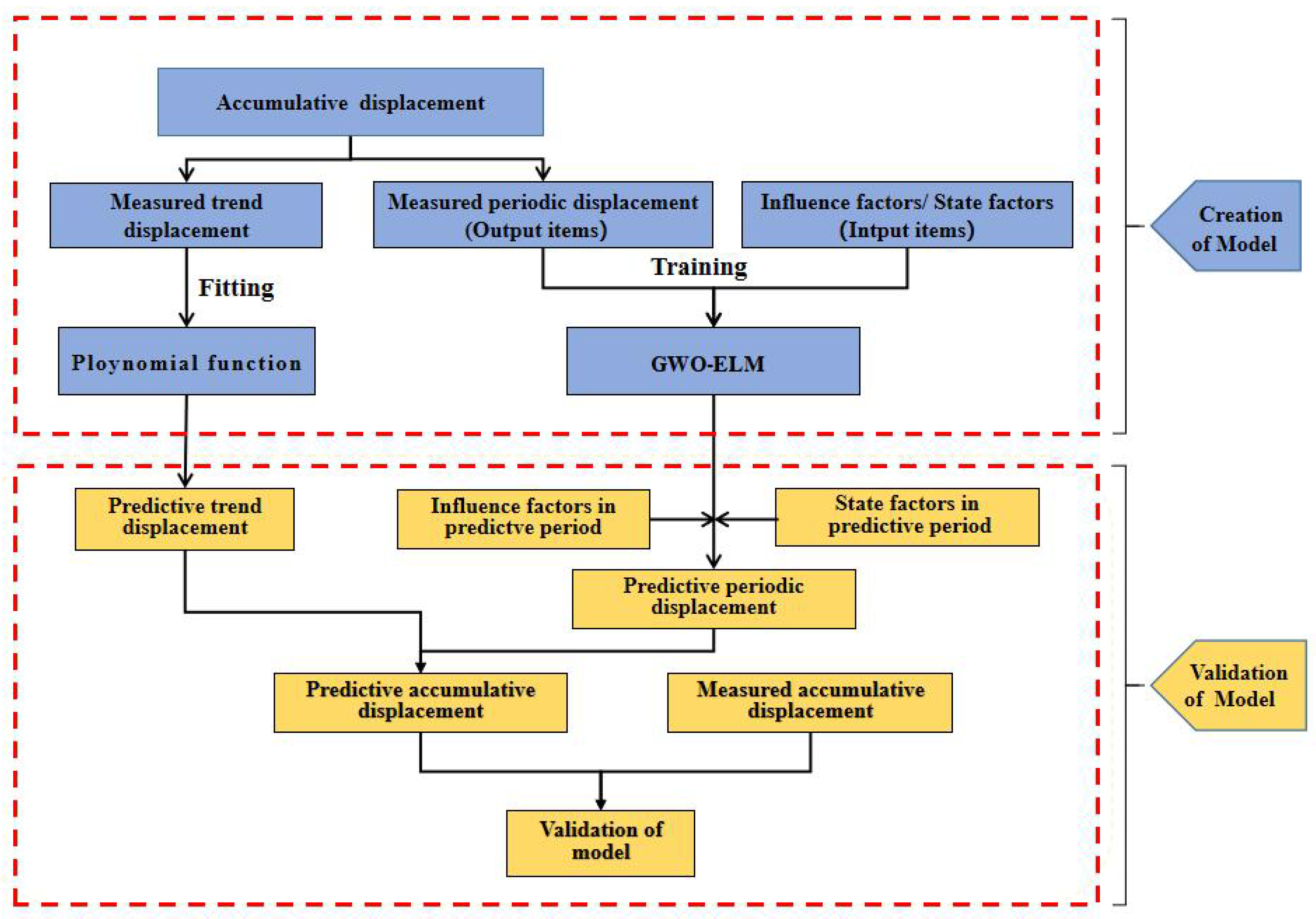
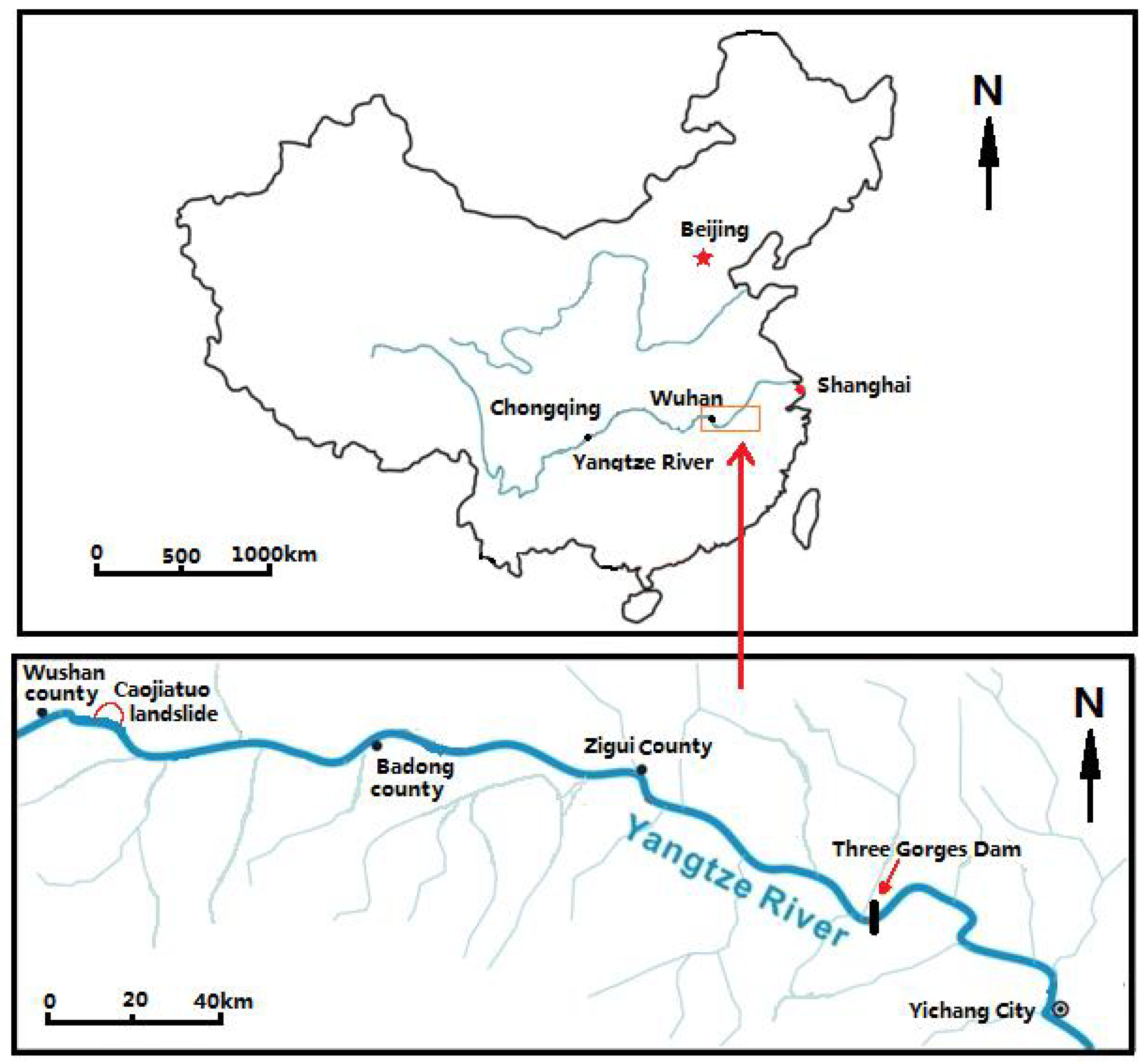

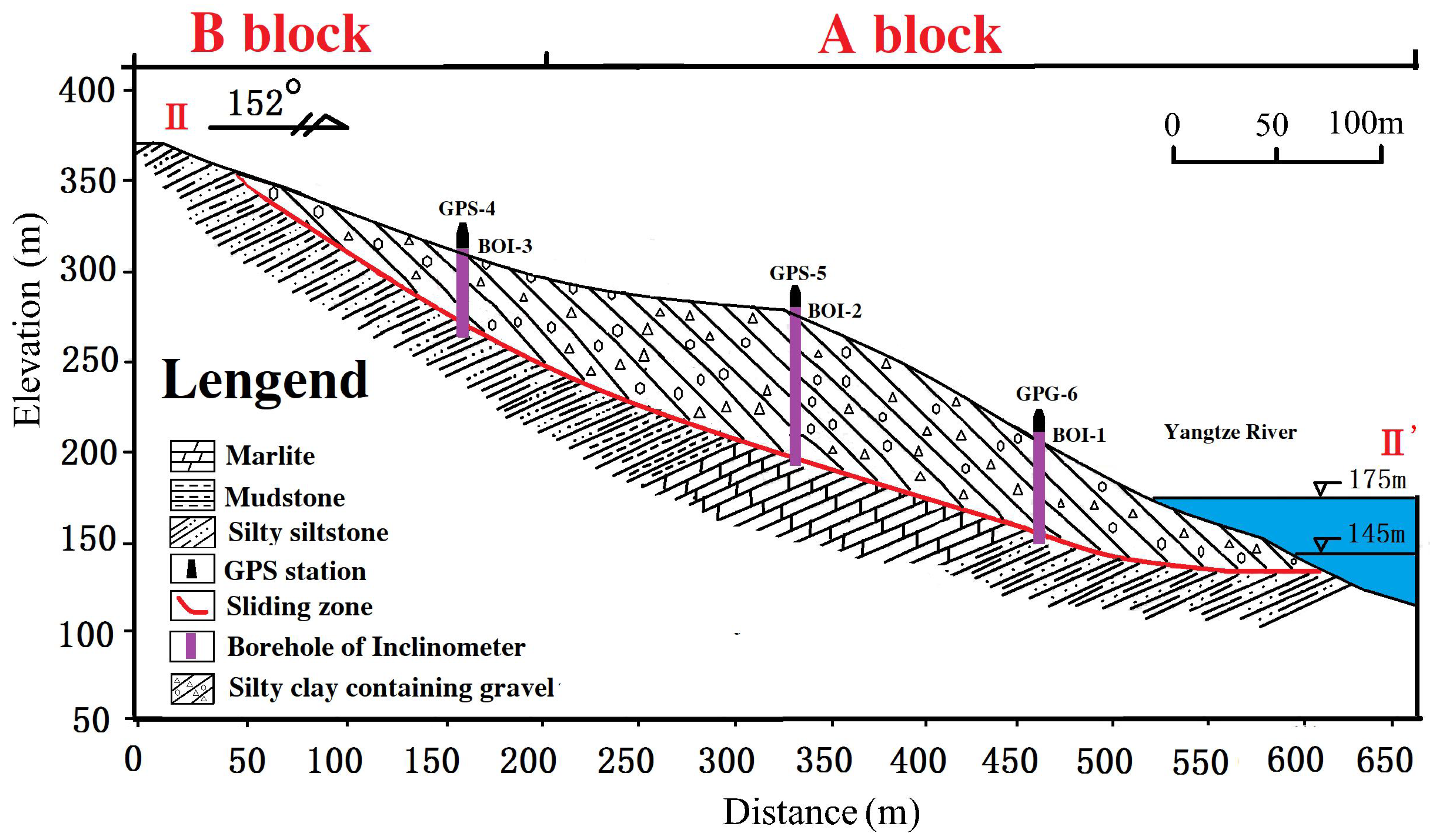
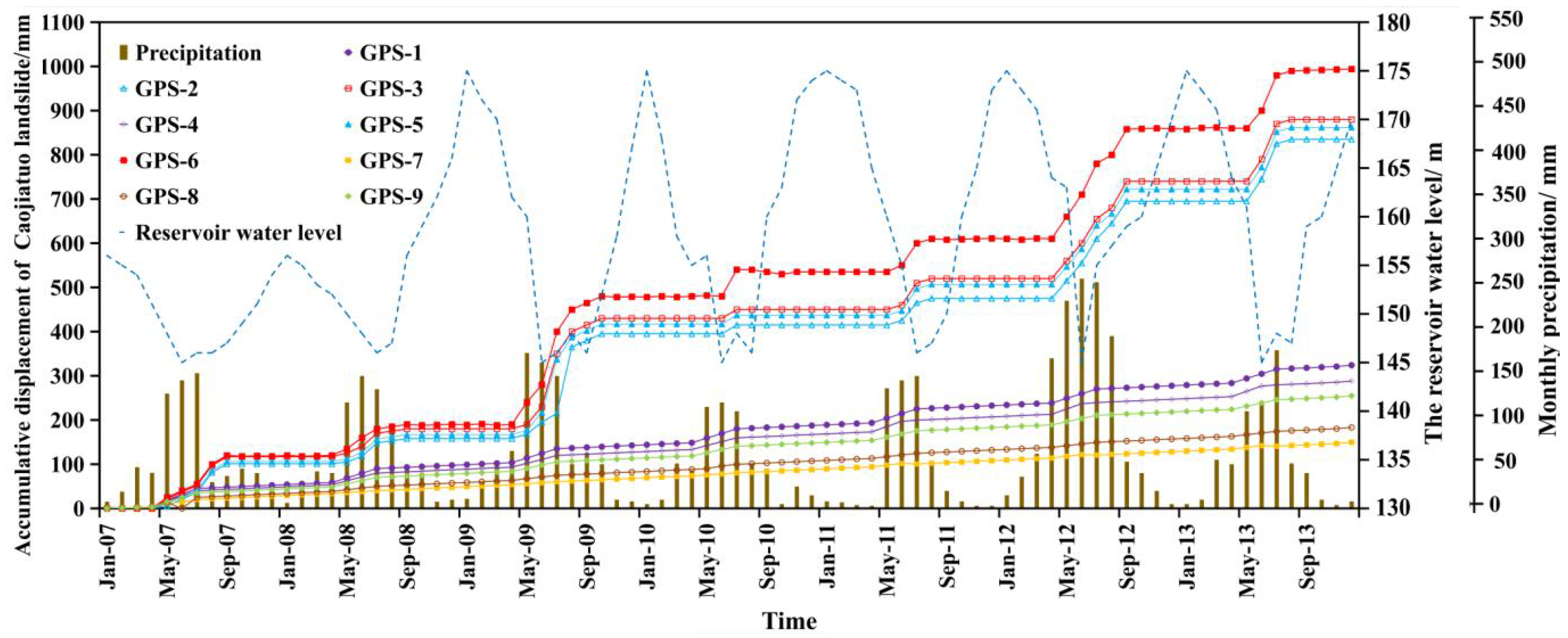
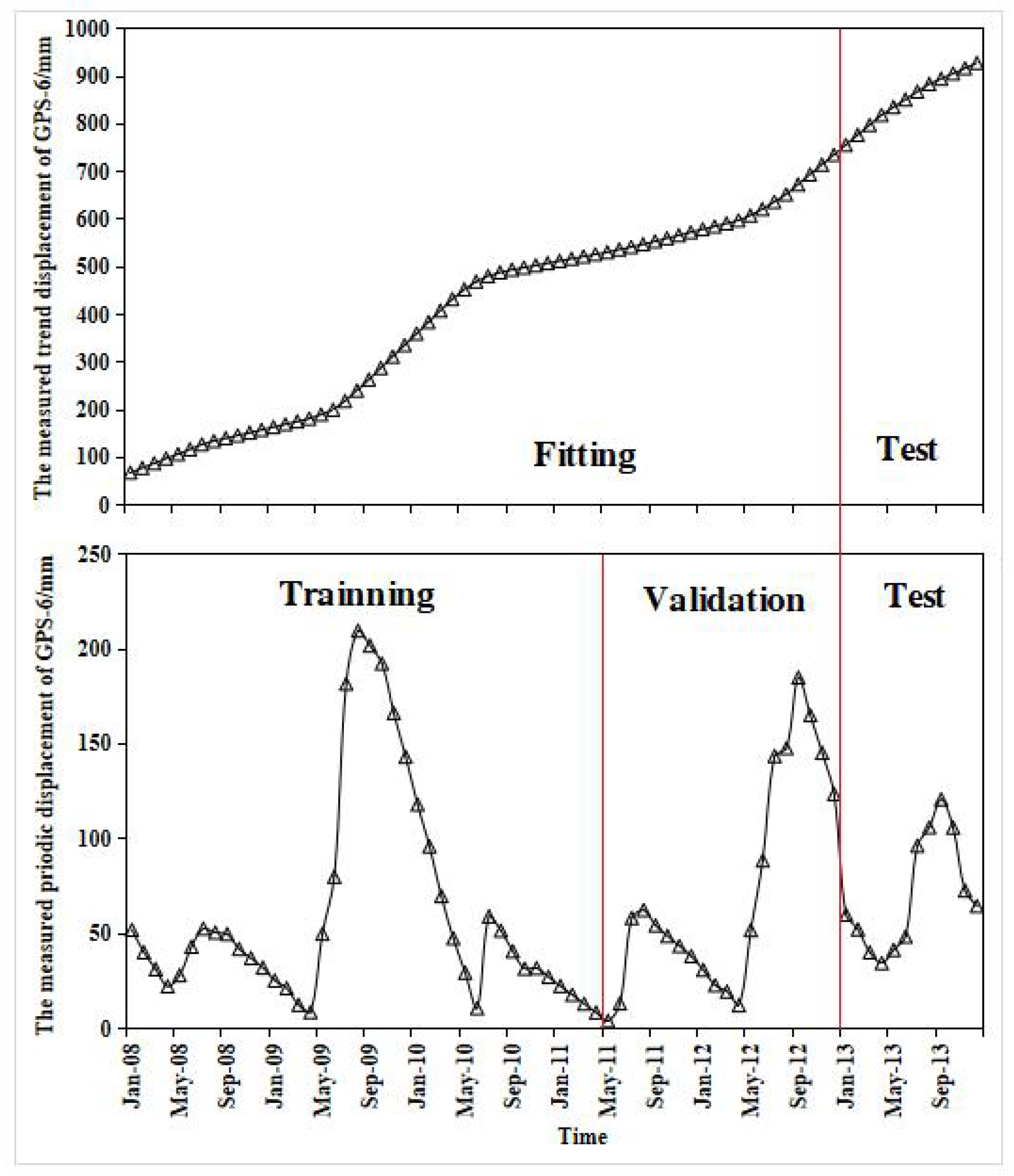
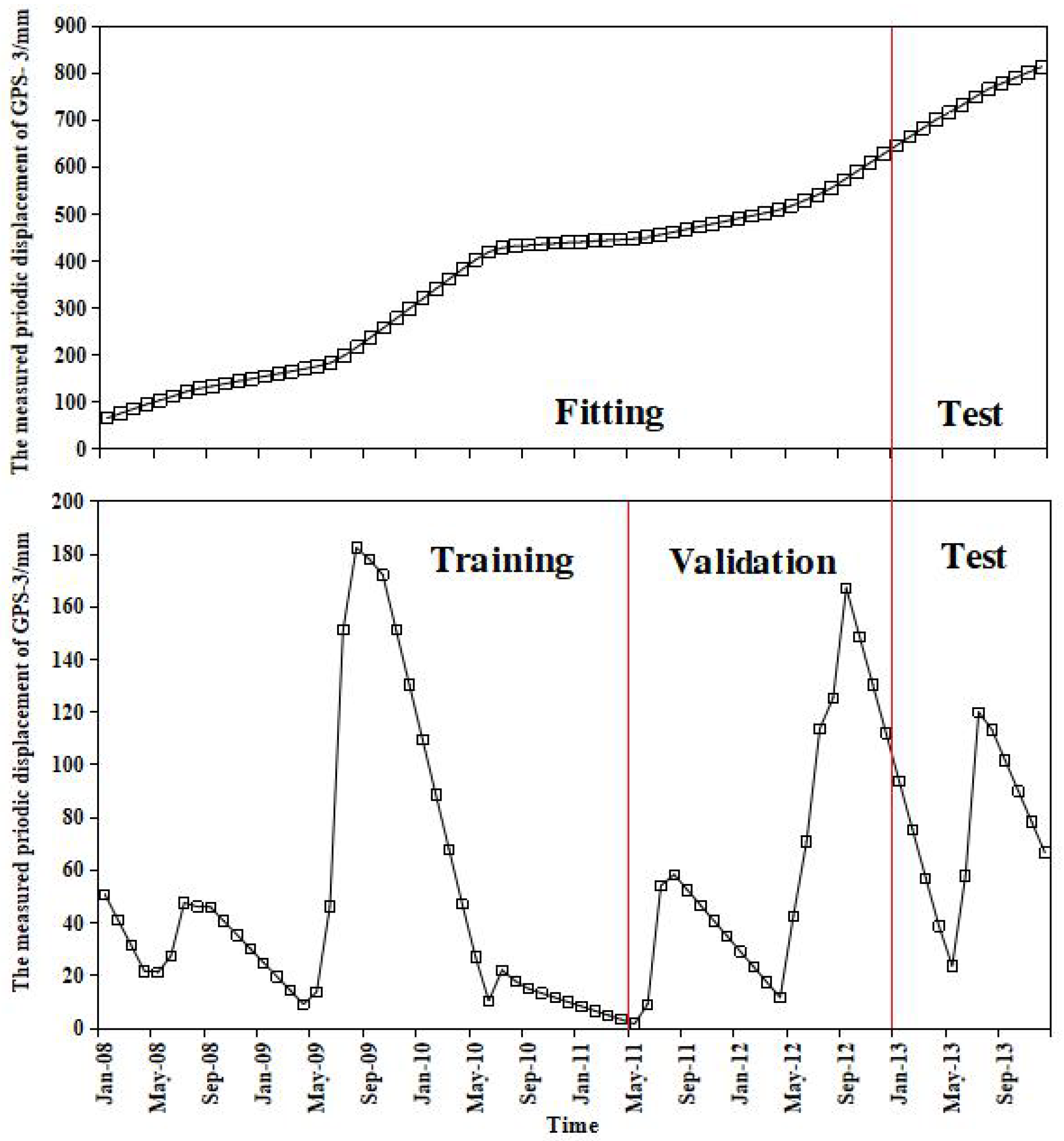
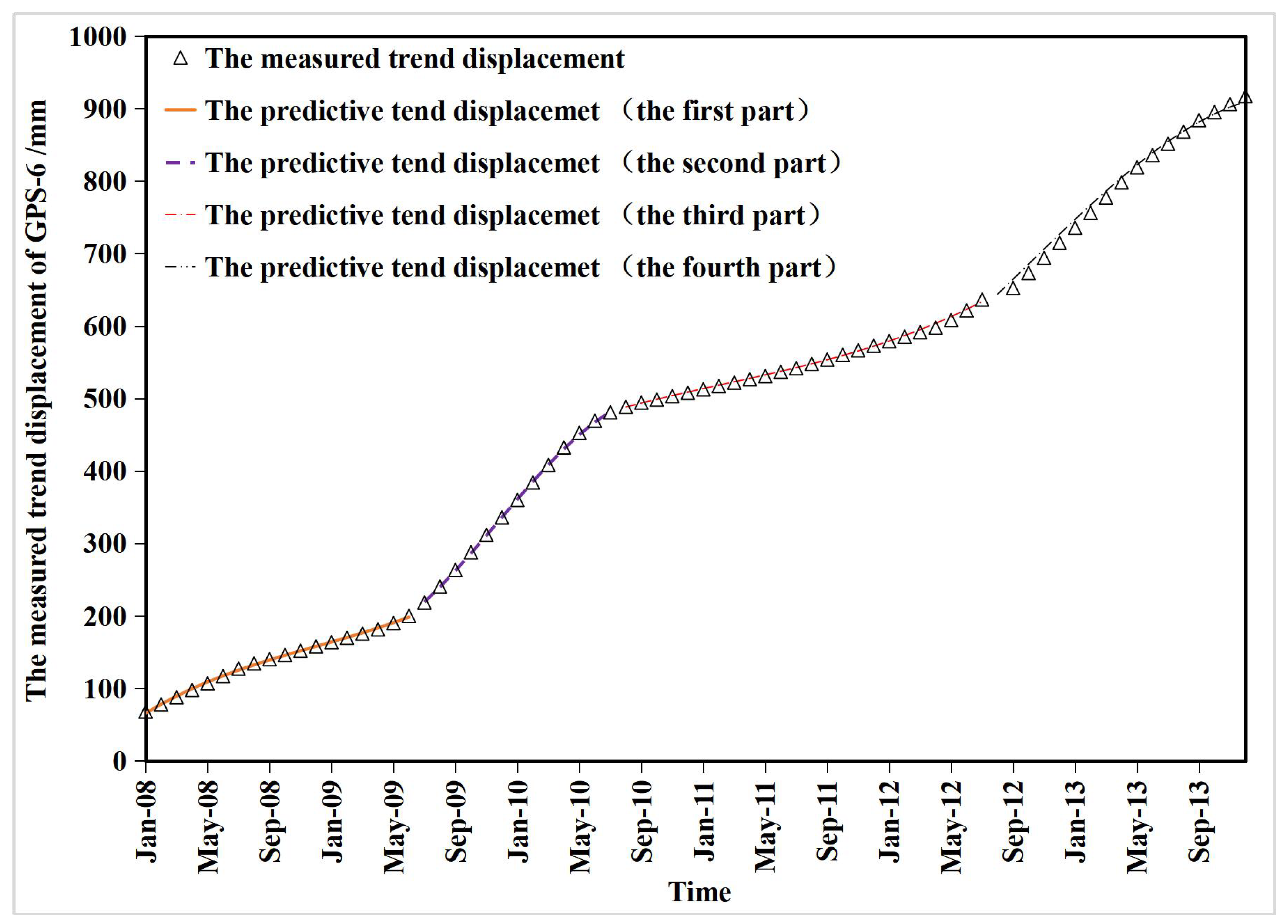
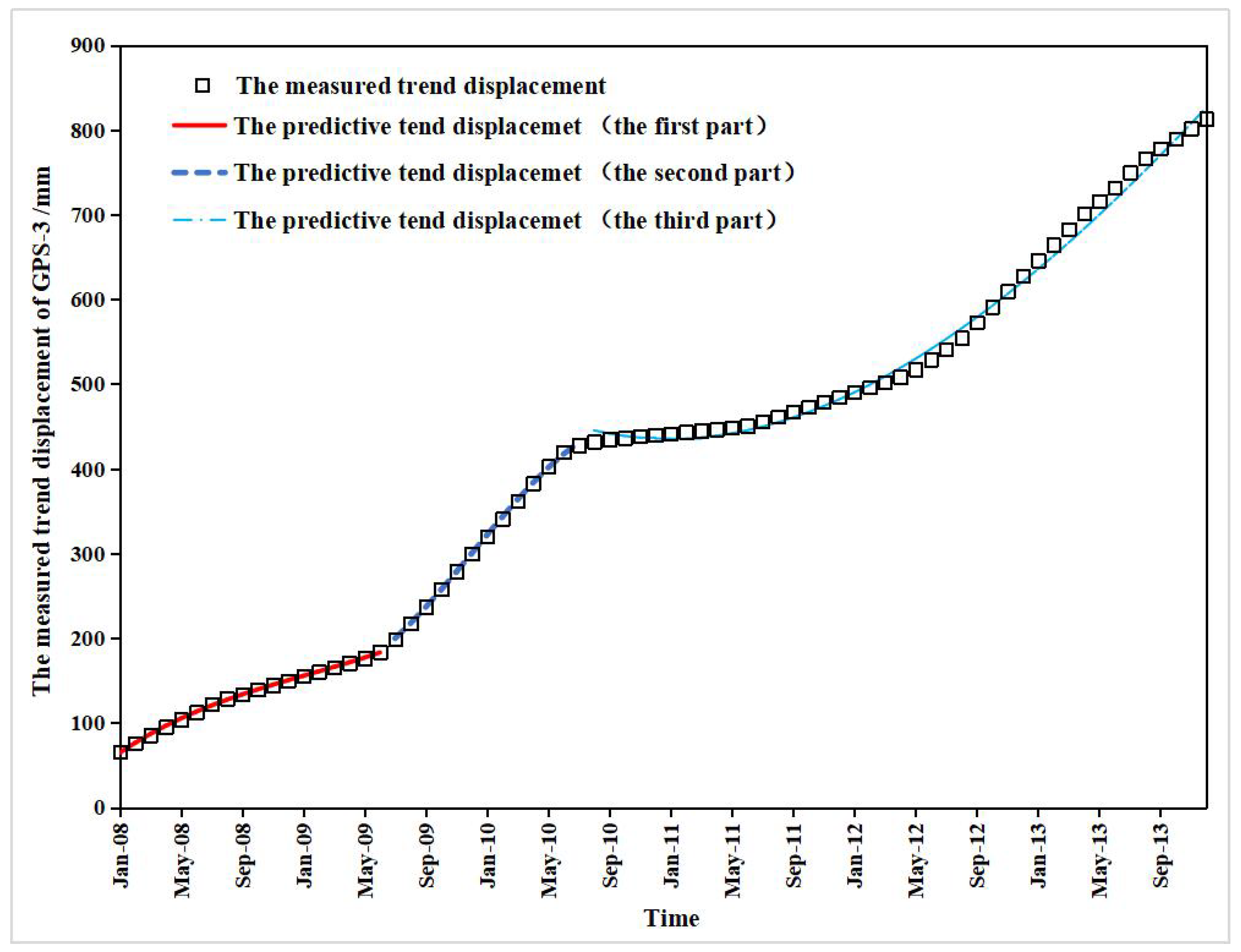
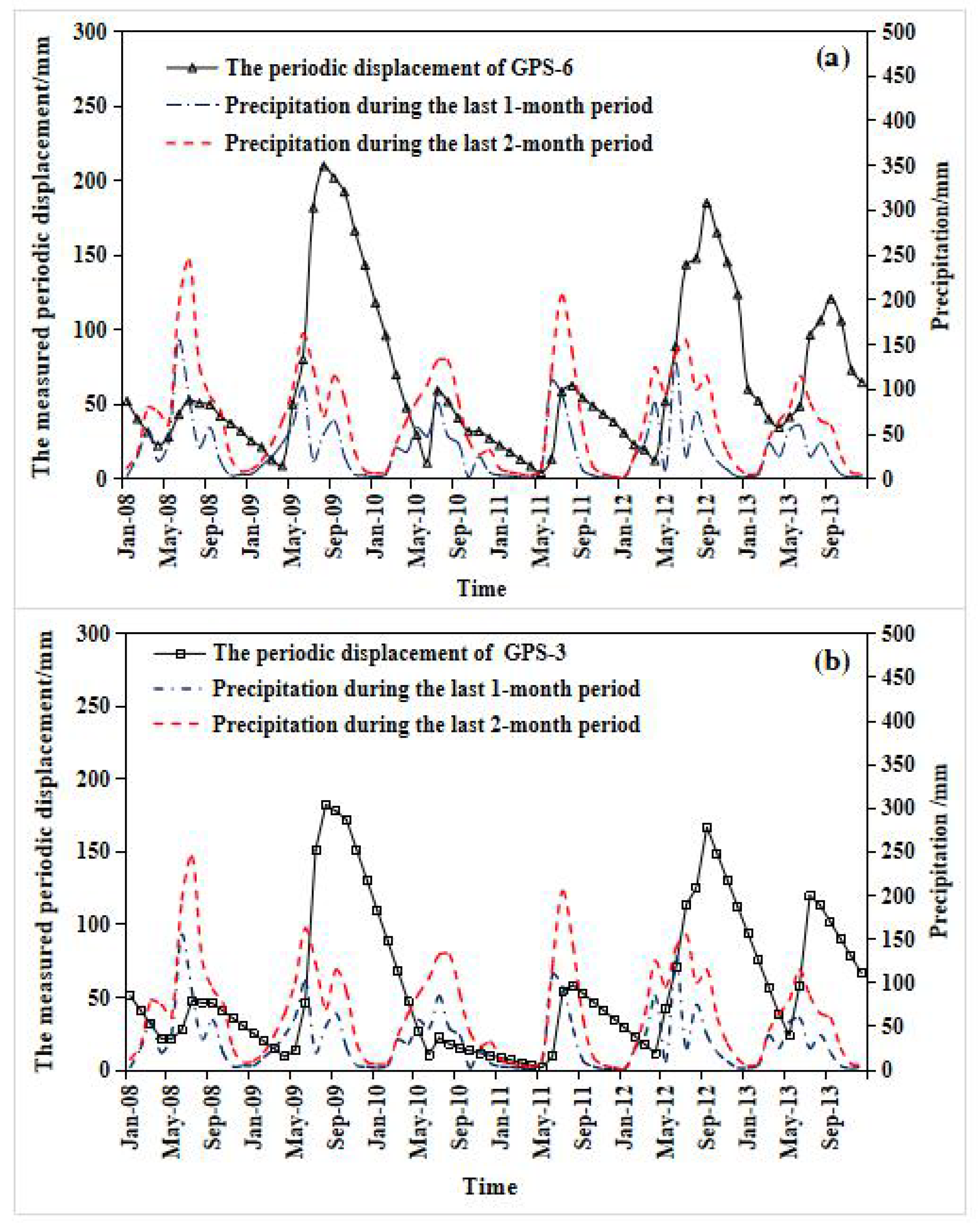

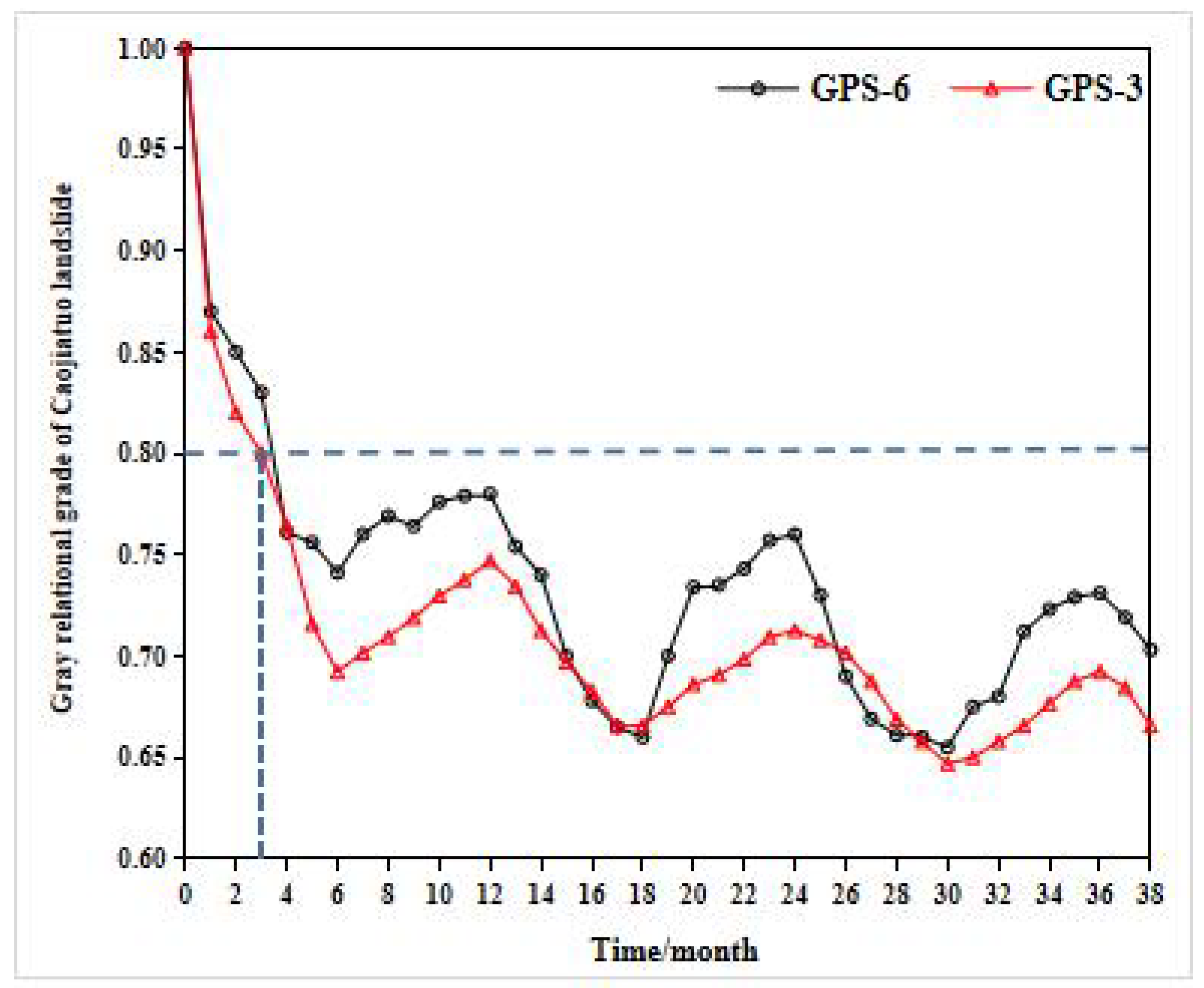
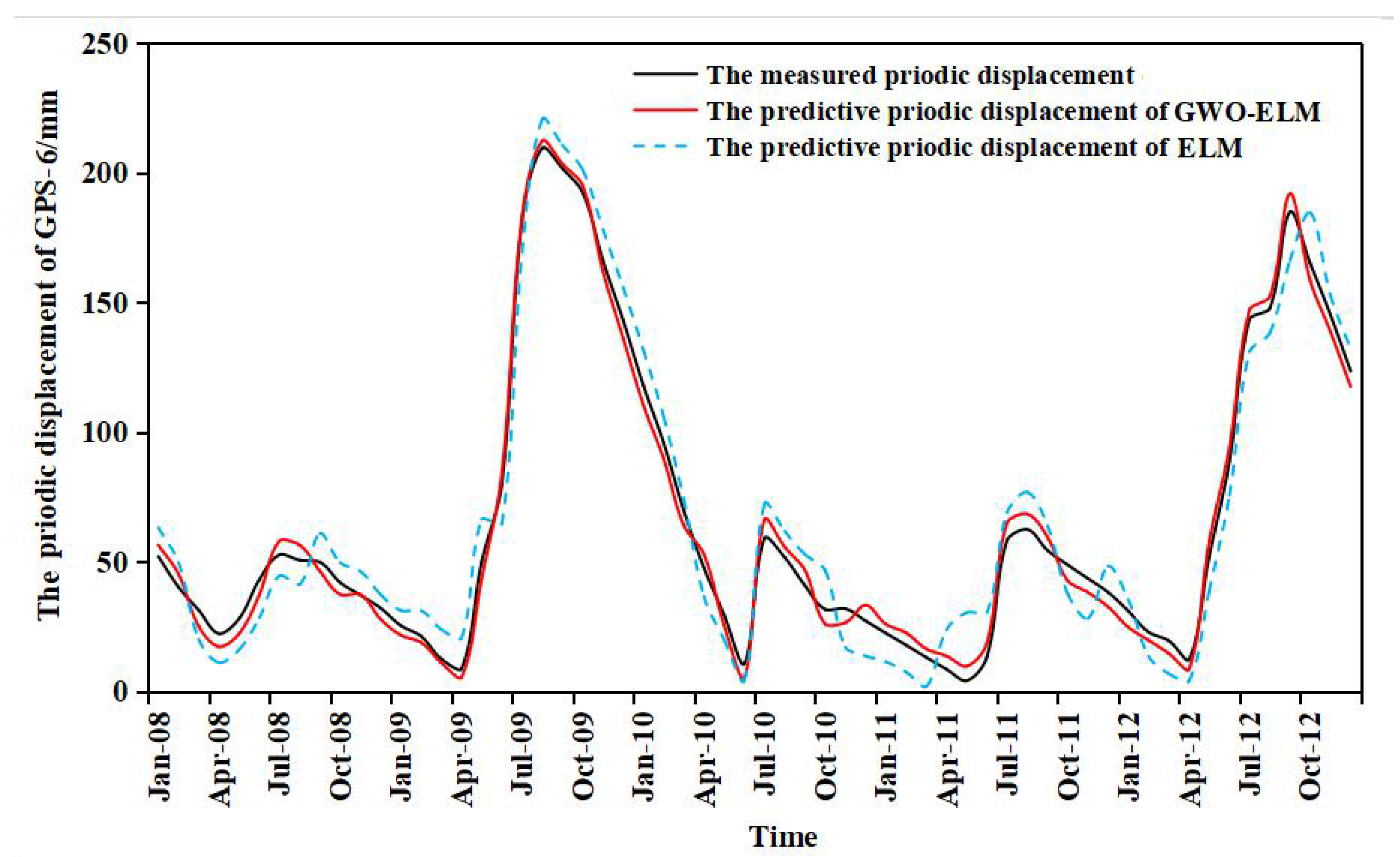
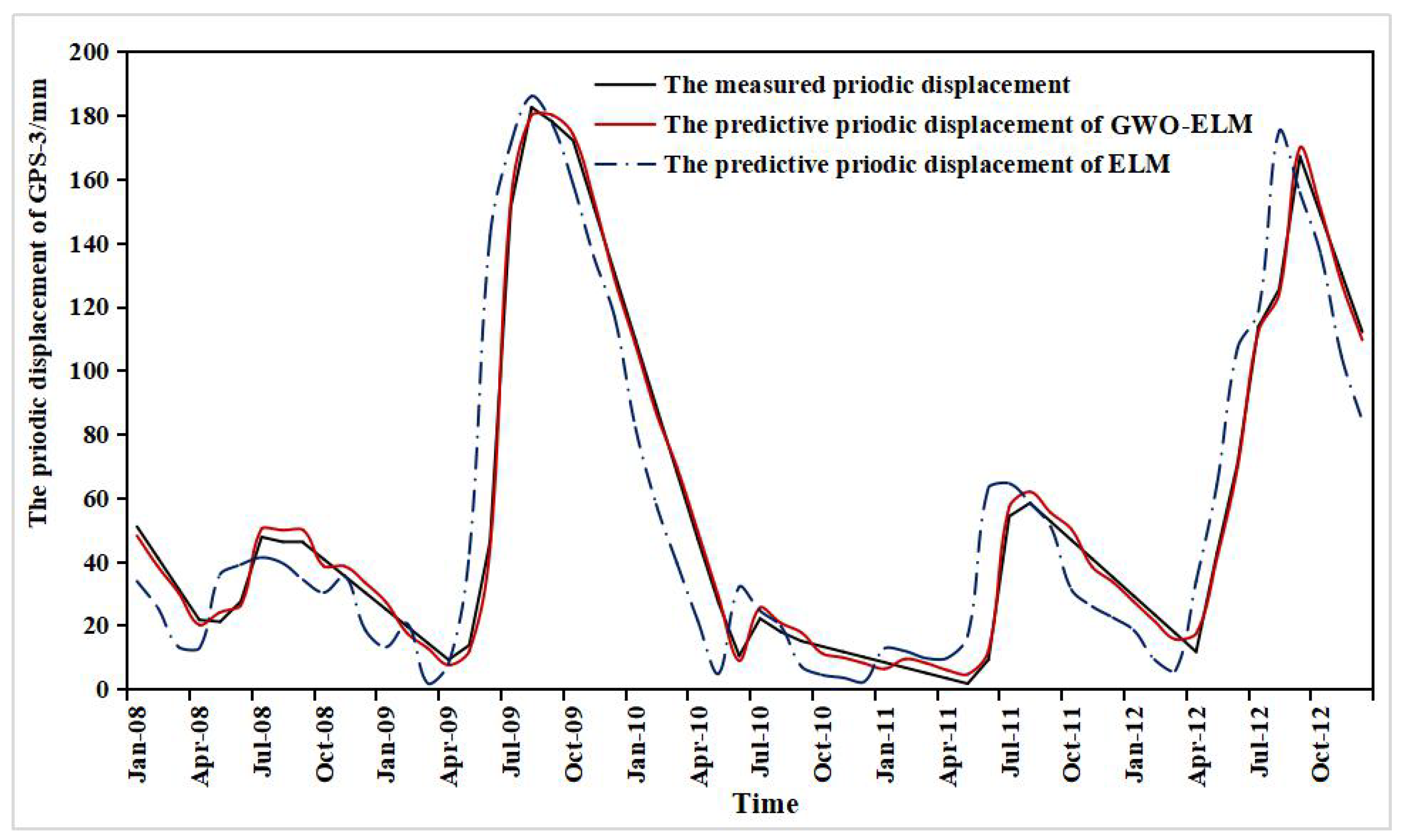
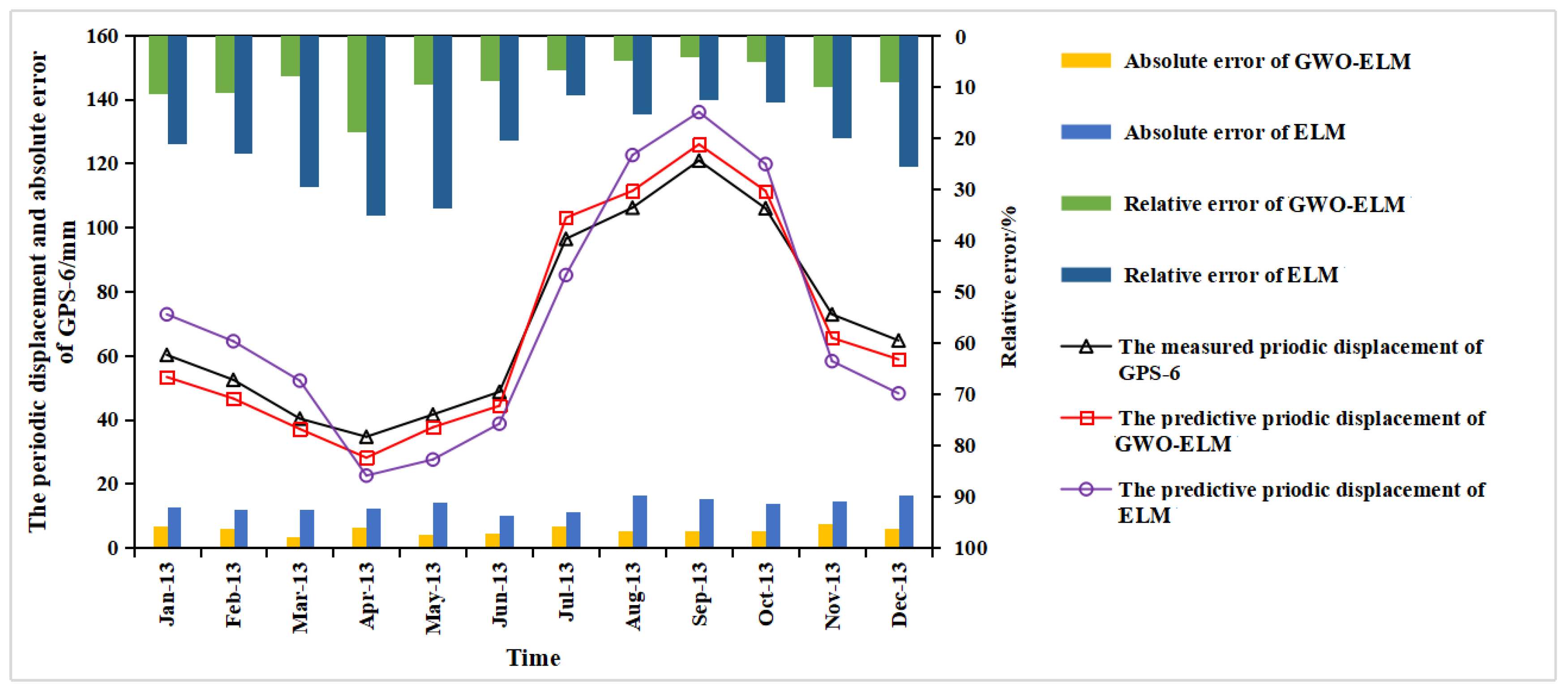
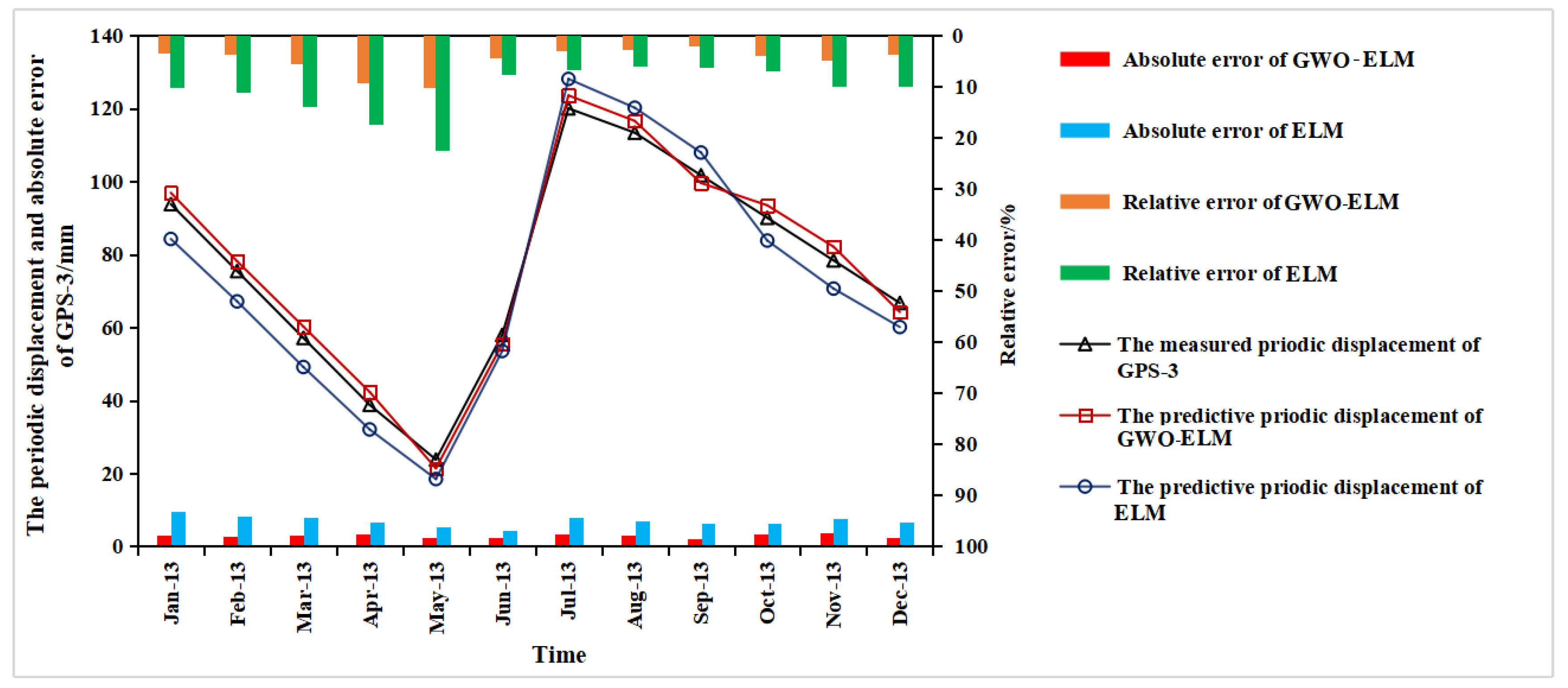
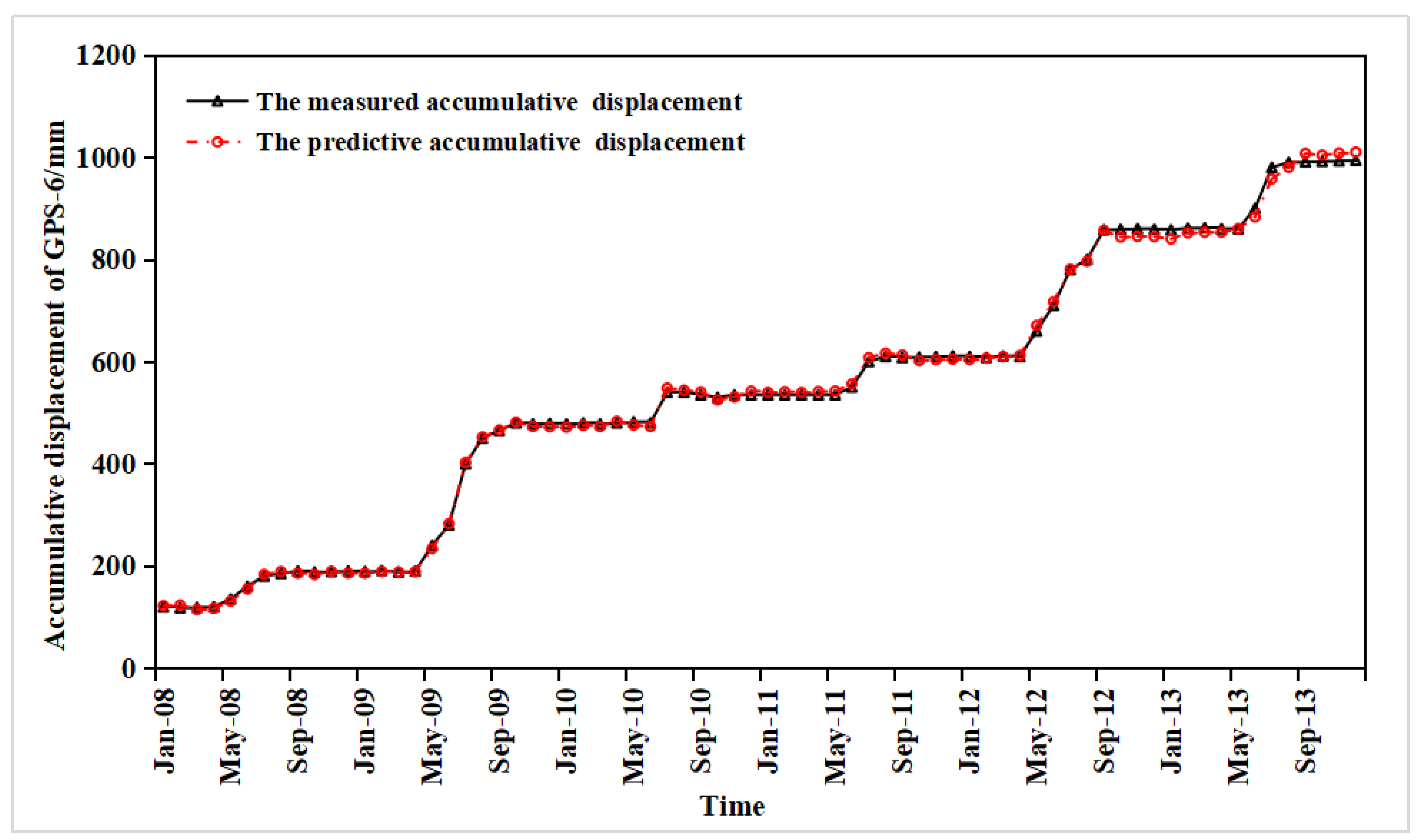

| Landslides | Monitoring Points | Period | a | b | c | d | R2 |
|---|---|---|---|---|---|---|---|
| Caojiatuo Landslide | GPS-6 | January 2008 to June 2009 | 0.019 | −0.569 | 14.31 | 52.0 | 0.9987 |
| July 2009 to July 2010 | −0.0794 | 5.665 | −109.61 | 801.7 | 0.9998 | ||
| August 2010 to July 2012 | 0.0077 | −0.886 | 38.65 | −94.1 | 0.9982 | ||
| August 2012 to December 2013 | −0.0238 | 4.132 | −218.30 | 4090.7 | 0.9998 | ||
| GPS-3 | January 2008 to June 2009 | 0.0152 | −0.6089 | 13.317 | 51.855 | 0.9993 | |
| July 2009 to July 2010 | −0.0653 | 4.7216 | −92.024 | 691.59 | 0.9996 | ||
| August 2010 to July 2013 | −0.0025 | 0.6822 | −40.139 | 1113 | 0.9949 |
| Input Item | GPS-6 | GRG | GPS-3 | GRG | ||
|---|---|---|---|---|---|---|
| Precipitation | Input 1 | The one-month cumulative antecedent rainfall | 0.83 | Input 1 | The one-month cumulative antecedent rainfall | 0.82 |
| Input 2 | The two-month cumulative antecedent rainfall | 0.81 | Input 2 | two-month cumulative antecedent rainfall | 0.80 | |
| Reservoir level | Input 3 | Reservoir level change in one-month period | 0.88 | Input 3 | Reservoir level change in one-month period | 0.87 |
| Input 4 | Reservoir level change in two-month period | 0.86 | Input 4 | Reservoir level change in two-month period | 0.84 | |
| Input 5 | The average elevation of reservoir level in the current month | 0.86 | Input 5 | The average elevation of reservoir level in the current month | 0.82 | |
| Evolution | Input 6 | The displacement over the past one month | 0.87 | Input 6 | The displacement over the past one month | 0.86 |
| Input 7 | The displacement over the past two months | 0.85 | Input 7 | The displacement over the past two months | 0.82 | |
| Input 8 | The displacement over the past three months | 0.83 | Input 8 | The displacement over the past three months | 0.80 | |
| Model | GWO | ELM | ||||
|---|---|---|---|---|---|---|
| Number of Wolf Groups | Number of Iterations | Number of Neurons | Total Number of Nodes | Excitation Function | Application Type | |
| GWO-ELM | 30 | 220 | 10 | 70 | Sigmoid | 0(regression, fitting) |
| ELM | - | - | 10 | 70 | Sigmoid | 0(regression, fitting) |
| Time | The Measured Values (mm) | The GWO-ELM Model | The ELM Model | ||||
|---|---|---|---|---|---|---|---|
| Predictive Values (mm) | Absolute Error (mm) | Relative Error (%) | Predictive Values (mm) | Absolute Error (mm) | Relative Error (%) | ||
| 13 January | 60.12 | 53.2 | 6.9 | 11.47 | 72.8 | 12.7 | 21.08 |
| 13 February | 52.34 | 46.5 | 5.8 | 11.15 | 64.4 | 12.1 | 23.03 |
| 13 March | 40.22 | 37.0 | 3.2 | 8.04 | 52.1 | 11.9 | 29.49 |
| 13 April | 34.56 | 28.0 | 6.5 | 18.91 | 22.4 | 12.1 | 35.08 |
| 13 May | 41.50 | 37.5 | 4.0 | 9.57 | 27.5 | 14.0 | 33.83 |
| 13 June | 48.58 | 44.2 | 4.4 | 8.96 | 38.6 | 9.9 | 20.47 |
| 13 July | 96.36 | 103.0 | 6.6 | 6.84 | 85.1 | 11.3 | 11.74 |
| 13 August | 106.08 | 111.3 | 5.3 | 4.95 | 122.5 | 16.4 | 15.49 |
| 13 September | 120.79 | 125.9 | 5.1 | 4.20 | 135.9 | 15.1 | 12.54 |
| 13 October | 105.90 | 111.3 | 5.4 | 5.11 | 119.7 | 13.8 | 13.03 |
| 13 November | 72.77 | 65.4 | 7.3 | 10.06 | 58.2 | 14.6 | 20.05 |
| 13 December | 64.62 | 58.7 | 5.9 | 9.11 | 48.1 | 16.5 | 25.56 |
| Min | N/A | N/A | 3.2 | 4.20 | N/A | 9.9 | 11.74 |
| Max | N/A | N/A | 7.3 | 18.91 | N/A | 16.5 | 35.08 |
| Mean | N/A | N/A | 5.5 | 9.03 | N/A | 13.4 | 21.78 |
| RMSE | N/A | 5.66 | N/A | N/A | 13.52 | N/A | N/A |
| Time | The Measured Values (mm) | The GWO-ELM Model | The ELM Model | ||||
|---|---|---|---|---|---|---|---|
| Predictive Values (mm) | Absolute Error (mm) | Relative Error (%) | Predictive Values (mm) | Absolute Error (mm) | Relative Error (%) | ||
| 13 January | 93.8 | 96.9 | 3.1 | 3.33 | 84.2 | 9.5 | 10.18 |
| 13 February | 75.4 | 78.1 | 2.7 | 3.56 | 67.1 | 8.3 | 11.02 |
| 13 March | 57.1 | 60.2 | 3.1 | 5.47 | 49.1 | 8.0 | 13.95 |
| 13 April | 38.8 | 42.3 | 3.6 | 9.18 | 32.0 | 6.7 | 17.37 |
| 13 May | 23.8 | 21.4 | 2.4 | 10.09 | 18.4 | 5.3 | 22.44 |
| 13 June | 57.9 | 55.4 | 2.5 | 4.31 | 53.5 | 4.4 | 7.61 |
| 13 July | 120.0 | 123.5 | 3.5 | 2.96 | 128.1 | 8.1 | 6.73 |
| 13 August | 113.3 | 116.6 | 3.2 | 2.85 | 120.2 | 6.8 | 6.04 |
| 13 September | 101.7 | 99.5 | 2.1 | 2.09 | 107.9 | 6.2 | 6.13 |
| 13 October | 90.0 | 93.4 | 3.4 | 3.82 | 83.8 | 6.2 | 6.92 |
| 13 November | 78.3 | 82.1 | 3.8 | 4.79 | 70.6 | 7.7 | 9.85 |
| 13 December | 66.7 | 64.2 | 2.5 | 3.72 | 60.1 | 6.6 | 9.87 |
| Min | N/A | N/A | 2.1 | 2.09 | N/A | 4.4 | 6.04 |
| Max | N/A | N/A | 3.8 | 10.09 | N/A | 9.5 | 22.44 |
| Mean | N/A | N/A | 3.0 | 4.68 | N/A | 7.0 | 10.67 |
| RMSE | N/A | 3.04 | N/A | N/A | 7.12 | N/A | N/A |
© 2020 by the authors. Licensee MDPI, Basel, Switzerland. This article is an open access article distributed under the terms and conditions of the Creative Commons Attribution (CC BY) license (http://creativecommons.org/licenses/by/4.0/).
Share and Cite
Zhang, L.; Chen, X.; Zhang, Y.; Wu, F.; Chen, F.; Wang, W.; Guo, F. Application of GWO-ELM Model to Prediction of Caojiatuo Landslide Displacement in the Three Gorge Reservoir Area. Water 2020, 12, 1860. https://doi.org/10.3390/w12071860
Zhang L, Chen X, Zhang Y, Wu F, Chen F, Wang W, Guo F. Application of GWO-ELM Model to Prediction of Caojiatuo Landslide Displacement in the Three Gorge Reservoir Area. Water. 2020; 12(7):1860. https://doi.org/10.3390/w12071860
Chicago/Turabian StyleZhang, Liguo, Xinquan Chen, Yonggang Zhang, Fuwei Wu, Fei Chen, Weiting Wang, and Fei Guo. 2020. "Application of GWO-ELM Model to Prediction of Caojiatuo Landslide Displacement in the Three Gorge Reservoir Area" Water 12, no. 7: 1860. https://doi.org/10.3390/w12071860
APA StyleZhang, L., Chen, X., Zhang, Y., Wu, F., Chen, F., Wang, W., & Guo, F. (2020). Application of GWO-ELM Model to Prediction of Caojiatuo Landslide Displacement in the Three Gorge Reservoir Area. Water, 12(7), 1860. https://doi.org/10.3390/w12071860






